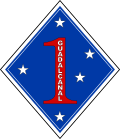This article needs additional citations for verification. (March 2008) |

This is the order of battle for the Guadalcanal Campaign, called Operation Watchtower, the first major Allied offensive in the Pacific Theater of Operations in World War II. The campaign lasted from the initial American landings on 7 August 1942 until the final Japanese evacuation on 9 February 1943, a period of six months, far longer than was expected by Allied planners.
The 7 August landings on Guadalcanal itself and Tulagi across Savo Sound (the site of a Japanese seaplane base) were carried out by US Marines under the command of Major General Alexander A. Vandegrift. These were followed by units of the Naval Construction Battalions, known as CB's or Seabees.
Forces of the US Army began arriving to relieve the exhausted Marines on 13 October. On 8 December Vandegrift was replaced by Major General Alexander M. Patch, US Army, who was named commander of the XIV Army Corps on 2 January 1943. Patch declared the island secure on 9 February.
The high command of the Imperial Japanese Army did not take initially the Allied effort on Guadalcanal seriously and committed units piecemeal throughout the fall of 1942. Over the course of the campaign, the Japanese subjected two entire infantry divisions to massive attrition on the island.

The 1st Marine Division's struggle to take Guadalcanal achieved legendary status: the heat and mud, the malaria and dysentery, the giant tropical insects and the fanatical, often suicidal, resistance of the Japanese combined to create an immense amount of sheer suffering. Today, the unit's insignia features the word "Guadalcanal" superimposed on a large red numeral 1. Three future commandants of the Marine Corps fought on "The Canal": Alexander A. Vandegrift, Clifton B. Cates and Lemuel C. Shepherd. Vandegrift was awarded the Medal of Honor the following year in recognition of his courage and extraordinary leadership during the Corps's four-month struggle.

Why does the mere mention of the southwest Pacific cause the men who fought there to shudder? Why does so genteel an author as Herman Wouk, whipped into a white-lipped rage at the mere thought of Guadalcanal, write that it "was and remains 'that fucking island'"? Why was combat there considered — correctly – worse than Stalingrad?
— William Manchester, Goodbye, Darkness: A Memoir of the Pacific War (1980), p. 79
In addition to the action on the ground, the United States Navy and Imperial Japanese Navy fought several vicious and costly surface engagements at night in the waters of Savo Sound. Two nights after the initial landings, the US Navy experienced the worst open-water defeat in its history at the Battle of Savo Island. By the time the Japanese had given up on Guadalcanal, they had lost 2 battleships, 2 heavy cruisers and 7 destroyers; Allied losses included 5 heavy cruisers (one of which was Australian), 2 light cruisers and a destroyer. Each side had an admiral killed in combat. After the war, the area was renamed Ironbottom Sound in reference to the number of ships sunk there.
© MMXXIII Rich X Search. We shall prevail. All rights reserved. Rich X Search
